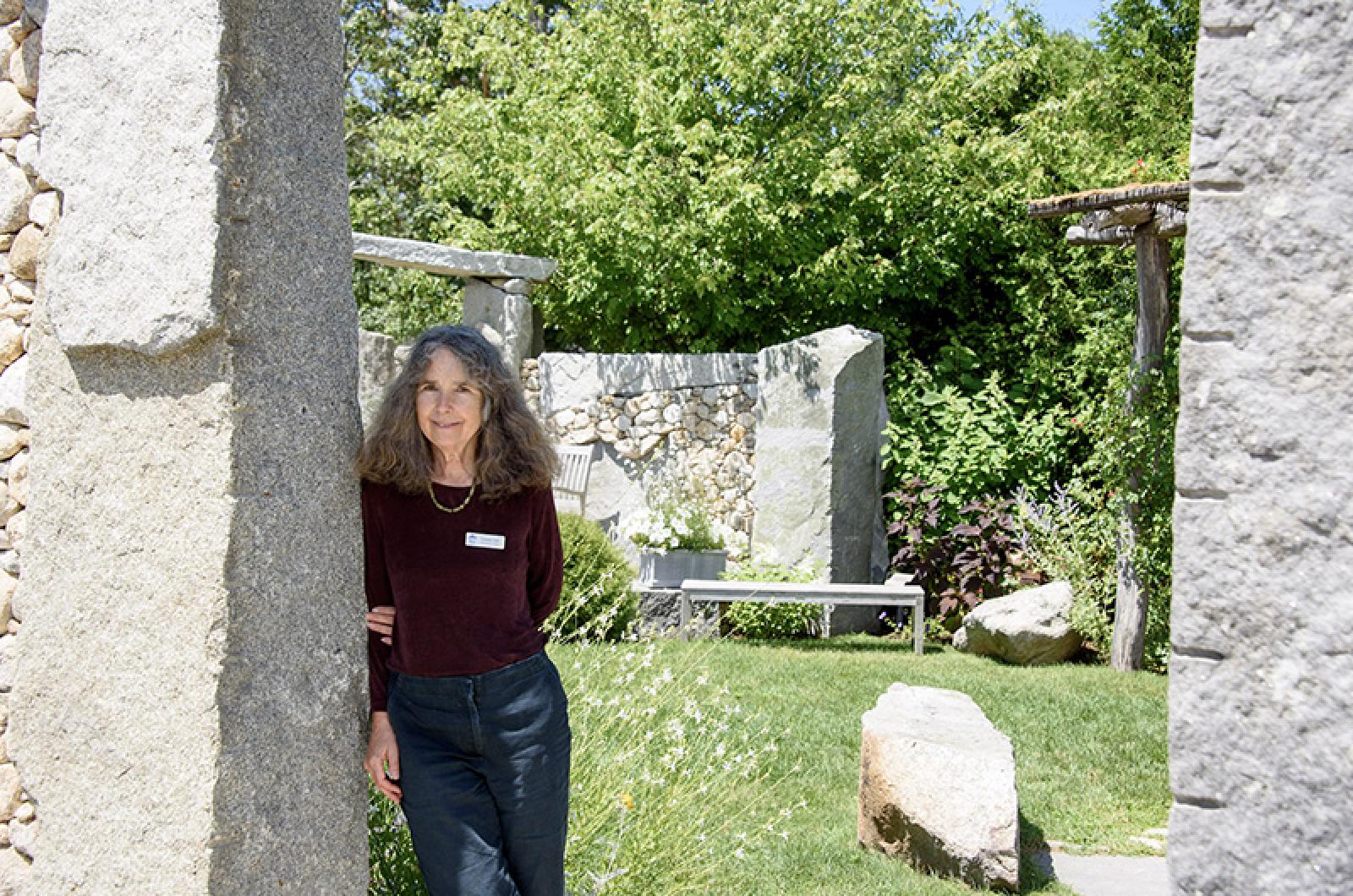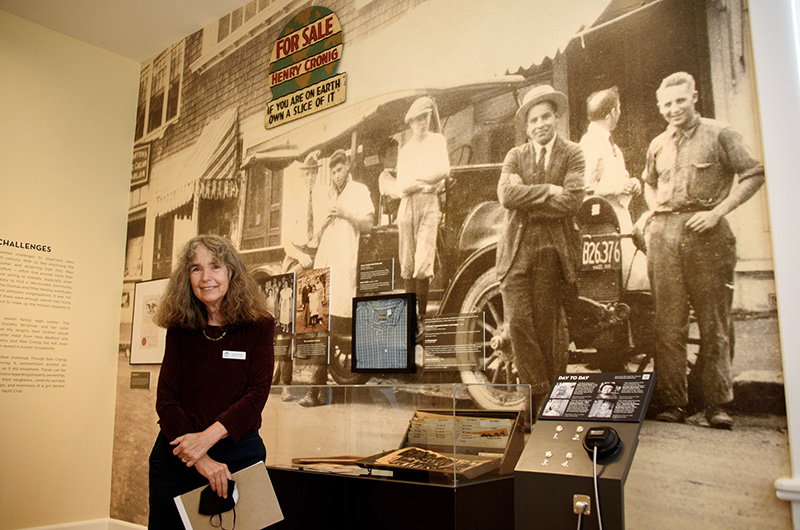At the Martha’s Vineyard Museum, history speaks in every room. Through panel texts, recordings and videos, the voices of long-gone Islanders still testify to an earlier way of life, and help shed light on what it means to be from the Vineyard.
Farmers and fishermen, boat builders and teachers, Wampanoag and African American elders and the families of the Island’s earliest Jewish immigrants are among the more than 1,000 people interviewed over 40-plus years by the museum’s oral historian, Linsey Lee.
“My love really is for exploring and finding treasures,” said Ms. Lee, during a Gazette interview at the museum last week.
Ms. Lee first moved full-time to Martha’s Vineyard in the early 1970s, foraging for wild foods, working odd jobs and listening to tall tales from Islanders she met.
She lived in a converted turkey coop and in a pondside tipi, and recalls one year when she skated home through frozen-over, snowy woods and pulled oysters through a hole in the ice.
“That winter you could actually skate right out to Quansoo,” Ms. Lee said, with a reminiscing smile.
To stay on the Island, the young Ms. Lee cleaned houses and worked at places like the Scottish Bakehouse and the former Mandala Bookstore. A more lucrative winter sideline, shucking scallops for Everett Poole in Menemsha, offered an early preview of her future career.
“This was the the forerunner of what got me into oral history,” Ms. Lee said.
“Everybody was there — 90-year-olds, 15 year olds — [because] it was a great way to earn money,” she recalled.
“I’d be talking to these old fishermen [and] they’d be telling me these great stories . . . I loved doing that, except it was cold,” Ms. Lee said. “I’d read all the right Vineyard history books, but these stories — these quixotic, contradictory, funny stories — brought the Vineyard alive to me, in a way the books hadn’t.”
Ms. Lee also wrote and illustrated a book of her own, about edible wild plants on the Vineyard, which was published in 1975.
“I spent about two years wandering around the Island . . . finding all the treasures, like an old abandoned well with bird’s-foot violets growing around it,” Ms. Lee said. “You could do that back then.”
She dipped a toe into oral-history waters more formally during college, when, for an Irish folklore course, she decided to interview Island raconteur and farmer Craig Kingsbury of Vineyard Haven.
“I was kind of intimidated by Craig,” said Ms. Lee, who knew Mr. Kingsbury from his deliveries of sheep stomachs to Scottish Bakehouse owner Isabella White for making haggis to celebrate Burns Night in January.
But Mr. Kingsbury — most famous off-Island as a cast member in the film Jaws who became star Robert Shaw’s character and dialogue model for the shark hunter Quint — was also the subject of some local notoriety that Ms. Lee intended to investigate.
Titled “I Didn’t Bring Any Skunks to the Island,” the interview with Mr. Kingsbury was later published in Ms. Lee’s 1993 book Vineyard Voices, the first of three volumes drawn from her oral histories.
“First skunks I saw, Sis, was in 1962,” Mr. Kingsbury told Ms. Lee, whom he also called “Sweetie” and “My dear lady.”
He went on to talk about how to catch snapping turtles, cultivate cranberries and brew acceptable moonshine, among other anecdotes in what remains both a vivid example of Island storytelling and a pivotal moment in the interviewer’s career.
“Craig really firmed it up for me,” said Ms. Lee, who moved back to the Vineyard after college to start her oral history project in earnest with a $5,000 grant from philanthropist Mary Wakeman and a donation of professional recording equipment from what is now the Martha’s Vineyard Bank.
“It was really my focus to get the stories from people who aren’t heard,” said Ms. Lee, who generally avoided celebrities.
“[Alfred] Eisenstadt is one of the few famous people I interviewed,” she said.
The early 1980s provided a good opportunity to collect Islanders’ recollections of earlier times, when the Vineyard was still a fairly isolated and traditional place, Ms. Lee said.
“There was a window on history that was open,” she said. “People still farmed and fished in ways that hadn’t changed appreciably in hundreds of years.”
The influence of mass communication was less noticeable in her early interviews with Islanders, some of whom were born in the late 1800s, Ms. Lee added.
“People . . . had grown up without television, some of them without radio, so talking was what they did — talking and visiting,” she said. “It was like they were singing, they would speak so beautifully.”
But after this second Vineyard sojourn, Ms. Lee wound up working in the movie industry and returning to the Island only for vacations. Traveling on location with filmmakers like Ismail Merchant and James Ivory was exciting, but Ms. Lee was less inspired by the commercial work she was finding in Boston.
“I got kind of fed up with . . . just how much money was spent on making stuff that was not that important,” she recalled.
As her focus shifted, Ms. Lee began working with homeless shelters in Cambridge, ran a farmer’s market and considered joining the clergy to push for social change.
Another move to the Vineyard was not part of the plan, but then came a fateful twist: On the brink of leaving the Boston area for divinity school in California, Ms. Lee suffered a bicycling accident that left her with a serious brain injury requiring months of rehabilitation.
“It brought me back here,” said Ms. Lee, who returned after rehab to the turkey coop turned beach shack where she had lived before, on family land in Vineyard Haven.
She also went to the Martha’s Vineyard Museum to offer her services — “I didn’t dare ask for money” at first, she admitted.
At a museum meeting in the early 1990s, she met Brendan O’Neill of the Vineyard Conservation Society. The two married in 1997 and are the parents of rising Martha’s Vineyard Regional High School senior Maya O’Neill.
In her early years at the museum, Ms. Lee’s interviews were developed into wall panels for exhibitions. But advances in technology have enabled her to bring the actual voices of Islanders into the ears of museum visitors through recordings and videos.
One notable example is the small exhibition on the history of the museum building, which began its life in 1895 as a hospital for seafarers and later hosted a mid-century sports camp. A video installation, with scrolling text, allows visitors to listen in as former camp personnel gleefully describe such summer pranks and rituals as the Underwear Tree.
Elsewhere in the museum, earphones and loudspeakers offer narratives about shipwrecks, lighthouses and other facets of Vineyard life.
Most recently, Ms. Lee and curator Bonnie Stacy worked on the new exhibition about Jewish life on Martha’s Vineyard, for which Ms. Lee is still conducting interviews.
Her goals now extend beyond preserving Island voices and stories for current and future generations. One thing she’d like her work to do, she said, is to help people — particularly older people — discover the value in their own lives, something that often comes as a surprise.
“Sometimes when I have a difficult time convincing someone to be interviewed, they [say], ‘My life has not been interesting,’” Ms. Lee said.
“Perhaps 30 minutes into the interview they often stop and say ‘Well, maybe my life has been interesting,’” she added. “This is a high point for me.”
Another mission that is close to Ms. Lee’s heart, she said, is that of training others in oral-history techniques and best practices that weren’t available to her in the 1970s, when the discipline was in its infancy. Ms. Lee and her assistant Laura Noonan had just begun developing the training when Covid hit, she said, and she wants to revive the project.
She also hopes to recruit more museum volunteers to help her transcribe the hundreds of audio and video interviews that have yet to be archived in text.
“These. . . are universal stories of immigration, women’s rights, racial injustice, equality, war, et cetera, et cetera, but they are told with a local lens that we can relate to,” she said.
For more information on the museum’s oral history project, visit mvmuseum.org/stories/, email stories@mvmuseum.org, or call 508-693-6309.








Comments (9)
Comments
Comment policy »